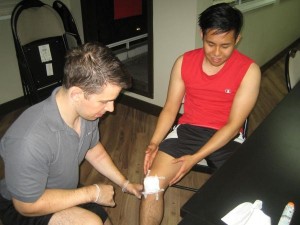Sea snake bites are not unheard of. Similar to their land relatives, sea snakes have venomous bites that area highly potent to toxic to their victims, humans included. All 52 species of sea snakes are venomous. These three to five feet long marine animals are characterized by their flat tails and scales and are found in the warm waters of the Pacific and Indian Oceans. No sea snakes are found by the Atlantic Ocean or Caribbean Sea.
Majority of these sea snakes are incapable of moving on land but can move quite speedily on water. They need air to breathe, thus they have to resurface after a maximum of two hours underwater. Although generally non-aggressive, sea snakes can turn aggressive when they feel threatened or cornered. While sea snakes are highly venomous, only a fifth actually result to envenomation. Their most common victims are fishermen.
Sea Snake Bites Symptoms
Once venom is injected by the fangs, symptoms may not manifest immediately. There is typically no pain, signs of redness, bruising and swelling, even if envenomation has occurred. Thus, people may ignore sea snake bites refusing to seek medical help. Symptoms of envenomation usually manifest within three hours and the common symptoms include:
- Nausea and vomiting
- Dizziness and headache
- Painful muscles
- Aches in the joints
- Inability to move the legs (paralysis)
- Blurry vision
- Droopy eyes
- Excessive salivation
- Sensation of thick tongue, accompanied by difficulty speaking or swallowing
*If no symptoms manifest within eight hours then it must connote that venom injection did not likely occur.
First Aid for Sea Snake Bites
Although one is unsure if venom was injected, it should be treated as such to avoid any complications. Medical help must be sought immediately. However, while waiting for medical attention, the following can be done:
- Apply the pressure immobilization technique:
- Wrap the limb starting from the distal ends of the limb toward the body using an elastic bandage. Make sure that there is still blood flowing to the extremities.
- Immobilize the affected limb with a splint to avoid any sorts of movement.
- For the first four to six hours, remove the elastic bandage for 90 seconds at a time every 10 minutes.
- Ensure that this is done within the first 30 minutes of the injury.
- Calm the casualty and keep him/ her warm. Ensure that the victim is comfortable at all times.
- Do not attempt to suck out the venom.
- Antivenin for sea snake bites is available and should be given immediately.
Prevention of Sea Snake Bites
Although first aid may be administered for sea snake bites, prevention is still the best key. Taking extra precaution will be advantageous in avoiding many injuries. To avoid sea snake bites:
- Avoid all contact with sea snakes. Even if they approach, do not attempt to catch them or make the first move.
- Always wear protective gear (thick wetsuits, gloves and diving boots), especially when one goes diving.
- Watch out for sea snakes in shallow waters
Treatment of Sea Snake Bites
Although they might not be generally present within the area, first aid should be known for all cases of emergency, especially if one decides to travel to tropical countries.Disclaimer: Although there is an antivenin for sea snake bites, giving first aid immediately can help significantly in avoiding further damages. The given information are not be used as medical advice or substitute for first aid training. To learn how to treat bites and stings of a wide variety of animals, including sea snake bites, enroll in First Aid Courses and CPR training, especially before joining high-risk activities and traveling to different countries.

